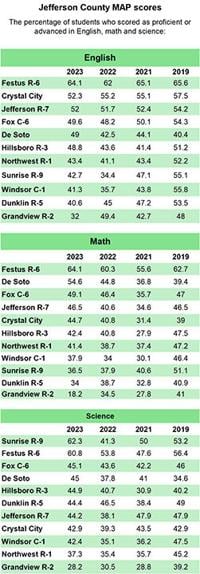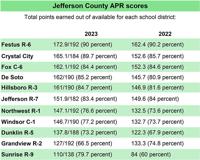All but one Jefferson County school district saw improvement in its Annual Performance Report (APR) in the second year of the revamped system.
The Grandview R-2 School District was the only county district that saw its score decline, dropping from 133.3 points (74.8 percent) to 127 (66.5 percent). Grandview Superintendent Matt Zoph attributed the lower score to the district offering the Missouri Virtual Academy (MOVA), an online educational program that enrolls students around the state. Since Grandview provides the online schooling program, all the scores from the students enrolled in it are included in Grandview’s APR score.
“We had 2,200 students in our score who have never been on our campus,” Zoph said of the students enrolled in MOVA for the 2022-2023 school year. “There are 642 (students) on campus. We partner with an outside company for the virtual school. They are working hard, but there are some inherent problems with virtual testing.
“Our Grandview kids come onto campus during the testing and are tested on one or two parts of a subject per day. For the virtual kids, they may have to drive an hour or two and then spend 12 to 14 hours to take every test in one day because they have to test in person. Most of the parents are unable to take them in to test over multiple days. If you sit a kid down for 14 hours to test, they are not going to be at their best.”
The Department of Elementary and Secondary Education (DESE) released the APR scores on Dec. 18.
The APR measures how well districts meet a range of expectations under the Missouri School Improvement Program, which is in its sixth iteration and is called MSIP 6. The APR considers graduation and attendance rates, advanced coursework, career preparation experiences, scores in reading and math, scores on the ACT and other national exams, and whether graduates enter college, the workforce or military service, according to DESE.
This is the second time the APR has been reported under the new criteria, which scores districts based on performance and continuous improvement. The data and test scores are from the 2022-2023 school year.
County’s top performers
The Festus R-6 School District once again was the top performing county district, earning 172.9 points (90 percent). The previous year, Festus received 162.4 points (90.2 percent).
“I am really proud of the performance overall,” Festus Superintendent Nicki Ruess said. “The Festus community has high expectations of us as a school district, which I think is great. I think our APR shows that strong performance and focus on student learning that is expected.”

Both the Festus and the Crystal City school districts scored in the top 10 percent of districts and charter schools in Missouri. The Crystal City district earned 165.1 points (89.7 percent), which was up from the previous year’s 152.6 points (85.7).
Statewide districts and charter schools scored an average of 77 percent.
“The data indicate that academic recovery is still needed,” said Margie Vandeven, the outgoing DESE commissioner who will be replaced by state Sen. Karla Eslinger this summer. “It is our hope that schools can use these data — along with local assessments and other key data points — to inform their continuous school improvement plans and to use this unique period of time in education to solve the issues moving forward.”
Accreditation
DESE is not using the latest round of APR scores to determine accreditation, but if it were, districts with scores at 95 percent or above would be accredited with distinction. Those scoring between 70 and 94.9 percent would be considered accredited. Districts with scores between 50 and 69.9 percent would be provisionally accredited, and those below 50 percent would be unaccredited.
DESE plans to use APR scores from the 2023-2024 school year to begin determining accreditation.
Grandview is the only Jefferson County district that would be provisionally accredited if the state were using the latest APR scores for accreditation. Districts with provisional accreditation get extra attention from the state Board of Education because they are at risk of losing accreditation entirely.
When a school district is unaccredited, it triggers a state law that allows students to transfer to higher performing districts, but no districts in the state currently are unaccredited.
“I can’t say there isn’t some concern (about Grandview), but we will try to improve both programs,” Zoph said. “We will make sure the kids on campus continue to do the best they can, and we will continue to improve the virtual kids also.”
All other county districts would be considered accredited based on the most recent APR scores.
More scores
The Fox C-6 School District had the third highest score with 162.1 (84.4 percent) up from the prior year’s 152.3 (84.6). The De Soto School District was fourth, with a 162 (85.2), up from 145.7 (80.9).

Next highest was the Hillsboro R-3 School District, which scored 161 (84.7 percent), up from 146.9 (81.6), followed by the Jefferson R-7 School District, with a 151.9 (83.4), up from 149.6 (84).
At the lower end of the scores was the Northwest R-1 School District, which was seventh, with a 147.1 (76.6), up from 132.5 (73.6). It was followed by the Windsor C-1 School District at 146.7 (77.2), up from 132.7 (73.7); Dunklin R-5 School District, with a 137.8 (73.2), up from 122.3 (67.9); and finally the Sunrise R-9 School District, which enrolls students in kindergarten through eighth grade and has fewer APR points available to earn. Sunrise scored a 110 (79.7), up from 84 (60).
“About 70 percent of schools in the state dropped in APR,” Dunklin Assistant Superintendent Joe Willis said. “In our county that is not the case; most of our schools went up. The Jefferson County schools as a whole are something to be proud of.”
On the Missouri Assessment Program (MAP) tests, which play a role in APR scores, Festus was the only county district with more than 50 percent of its students scoring as proficient or advanced in English language arts (64.1), math (64.1) and science (60.8).
The only other county school districts to have more than 50 percent of its students score as proficient or advanced in English were Crystal City (52.3) and Jefferson R-7 (52).
De Soto had 54.6 percent of its students score as proficient or advanced in math, and Sunrise had 62.3 percent of its students score as proficient or advanced in science.
The following is a closer look at how the county’s 11 districts performed in the APR and MAP:
Crystal City
The Crystal City district was one of 115 school districts in the state, about a third of the districts in Missouri, with a four-day school week during the 2022-2023 school year. Superintendent Crystal Reiter said the district’s APR and MAP performances do not necessarily prove that students can excel with fewer days of school.
However, she said she is proud of what the students and teachers have accomplished.
“Whether you are five days or four days, you are still required by the state department to complete the same number of hours,” she said. “While the 89.7 is amazing, what is even more important is that year over year we are making progress and moving forward. We will take a deeper look at where we scored points, where we are missing points and where we have opportunities.”
While more than half of Crystal City students scored as proficient or advanced in English, the 52.3 percent is a dip from 55.2 percent from 2022.
“While that is not a significant slip, it is not moving in the direction we want to move,” Reiter said. “We are focusing on LETRS training, which is the science of reading.”
Crystal City did see improved performance in math, rising from 40.8 to 44.7, and in science increasing from 39.3 to 42.9.
“In math, there was a change in curriculum,” Reiter said. “(During the prior year), the i-Ready Assessment (a test that matches the difficulty of questions to each student’s ability) was implemented in the district, and that gives teachers the opportunity to look at student performance over time and not just that one big test at the end of the year.”
De Soto
The De Soto district’s APR score jumped from 145.7 to 162.
Assistant Superintendent Ron Farrow, who will take over as the district’s superintendent at the end of this school year when Josh Isaacson retires, said some of that improvement can be attributed to the district offering more career and technical education (CTE) courses, more opportunities for students to earn advanced course points through Project Lead the Way and more opportunities for students to take the ACT.
“We are extremely proud of our students and staff,” Farrow said. “We continue to have an upward trajectory with our APR points and our state assessment scores. We are looking at continued growth with our APR.”
De Soto also saw significant increases in student performances in English, math and science on the MAP tests. The percentage of students scoring as proficient or advanced in English rose from 42.5 to 49; in math, from 44.8 to 54.6; and in science, from 37.8 to 45.
“It was a lot of hard work by our teachers,” Farrow said. “We have had a focus the last few years on data-driven instruction. We have utilized tools that allow our teachers to break down individual assessment questions by standards. They can see where students are struggling and where to provide support. It is all about getting down to the details. That is why we are on such a great trajectory.”
Dunklin
Joe Willis, assistant superintendent for the Dunklin schools, said part of the reason the district’s APR rose to 137.8 points (73.2 percent) from 122.3 (67.9) was because school staff had a better understanding of how DESE was scoring districts.
“Our rise was indicative of the changes we made once we knew what the targets were,” he said. “(The year before), a lot of the situations had nothing to do with students; it was targets that changed. We were one of the only schools to not get any attendance points (the previous year). We were able to focus on that.”
Dunklin did see MAP scores fall in English, math and science, though. In English, 40.6 percent of the district’s students scored at proficient or advanced, down from 45 percent the previous year.
In math, 34 percent scored at proficient or advanced, a decrease from 38.7 the year before, and in science, the number slipped to 44.4 from 46.5.
Willis said the slide comes after scores improved the year before, and based on the district’s testing, Dunklin students MAP performances is expected to improve this school year.
He also pointed out that 35 percent of Dunklin students who took the tests last year had been in the district for three years or less.
“It was weird,” Willis said. “What we found was the kids who have been here (longer) really achieved at a high level.”
Willis said the district is taking a closer look at new students’ abilities based on state standards to figure out if they may need additional academic help when entering Dunklin schools.
“We need to measure where they are at and fill in those gaps,” he said. “What we are seeing is by the time a kid graduates from high school in our district, if they have been in our program (from kindergarten through their senior year of high school), they do achieve at a really high rate.”
Festus
Ruess said the Festus district earned all the points possible for performance, which makes up 70 percent of a district’s APR score.
She also said it can be difficult for high performing districts to raise its APR because continuous improvement comprises 30 percent of the APR score.
“That growth formula, we can’t calculate on our own,” she said. “It is a statistical calculation formula that DESE does not provide to us. With performance, I can dig in with my principals to say, ‘This is where our kids are and this is how much we need to grow, but with that growth calculation, we don’t have the ability to calculate that. We never know what that is going to look like until they give us the draft. That is frustrating. It is hard to make improvements.”
Ruess said the instruction Festus students receive is what led to the increase in students’ MAP scores, which rose in English from 62 to 64.1; in math, from 60.3 to 64.1; and in science, from 53.8 to 60.8.
“Where the rubber meets the road is the day-to-day instruction,” she said. “That is a truer indication of improvement. If you are doing that well, your state assessment scores will reflect that.
“I meet with our individual principals and dig into the formative assessments that are happening throughout the school year. They write goals. During the fall semester, we talked about where the goals were and where we are at in the semester. We look at how many kids moved, what standards they improved on and what percentage of kids are at grade level or below grade level. What we do on a day-to-day basis should have an impact on our scores.
“It is a community effort from families, students, teachers and administrators. It is a partnership of us all working together to maintain that level of high performance.”
Fox
The Fox district’s APR score improved from 152.3 (84.6 percent) to 162.1 (84.4) after the district had more points available this cycle at 192 rather than 178 during the previous cycle.
Superintendent Paul Fregeau said he feels good about the district’s APR score.
“It puts us in the top 30 percent, or so, in the state of Missouri,” he said. “When I look at districts that are our size from 8,000 to 11,000 (students), we are No. 1. That is encouraging.”
However, Fregeau said the district can improve.
“We need to be better,” he said. “One great thing about DESE is they keep changing the game, so to speak. As we dive down into the data and look at how (DESE) is measuring growth, we need to analyze and determine our best opportunities to improve our scores.”
The district saw slight improvements on its MAP tests, with 49.6 percent of its students scoring as proficient or advanced in English, up from 48.2 percent the previous year. In math, 49.1 percent scored as proficient or advanced, up from 46.4 the year before, and in science, the percentage rose to 45.1 percent from 43.6.
“I commend our teaching staff who work with the kids every day. To be able to achieve that growth in a large district is commendable,” Fregeau said. “We try to provide teachers with the proper resources that are aligned with the standards that will be measured. I think in the last couple of years, we are seeing that pay off. Hopefully as we continue to align districtwide, kindergarten through senior in high school, that will allow the kids to be successful and our teachers to do their great work.”
Fregeau said a lot of variables affect student growth before MAP testing is administered in the spring.
He also said he believes Fox students will continue to show improvement in the APR and state tests.
“We are seeing a positive trend in the data, but it will all come down to a couple of days in the spring,” he said. “There are a lot of variables still to come. Are we going to miss a bunch of days with weather? What is the attendance going to be? Will we have the flu run through and impact the number of days students are sitting in front of our teachers?
“But with the structures we have in place and the consistency we have with resources and alignment to standards, we are very hopeful we will continue to improve.”
Grandview
Zoph said he hopes the state changes how virtual students take MAP tests this school year, which he believes could raise the district’s APR score.
“When you take in APR, which takes in more than the MAP test score, we lost most of our points through the virtual program,” he said, adding that the district has 3,200 students enrolled in MOVA this school year.
“We are hoping there are some changes in the state law to allow those kids to do some virtual testing so they don’t have to take the test in one day. I understand the worry about cheating. We are hoping that now that you can take the ACT virtually, why can’t you take the state test virtually? That is something DESE will have to decide.
“At this moment, we don’t know if we are going to get a true reading of how successful or unsuccessful our virtual program is.”
MAP scores were better among the students on the Grandview campus than its overall scores, which included the MOVA students.
Grandview students in third through eighth grade were tested in English and math, and students in fifth and eighth grade took the science tests.
Overall, 32 percent of Grandview students scored as proficient or advanced in English, down from 49.4 percent the year before. In math, scores dropped to 18.2 from 34.5, and in science, the score dipped to 28.2 from 30.5.
However, among the students who took classes at Grandview Elementary, 47.6 percent scored at proficient or advanced in English and 50.7 were proficient or advanced in math.
Students at Grandview Middle School also performed well, 41.8 percent scored at proficient or advanced in English and 37 percent were proficient or advanced in math. In science, 39.3 percent scored at proficient or advanced.
“I want our community to know the kids in the community are getting a great education,” Zoph said. “The on-campus test scores are doing great. The virtual program is working hard to make some improvements. The APR is not necessarily reflective of how the on-campus students are doing.”
Hillsboro
Melissa Hildebrand, assistant superintendent for curriculum and assessments at the Hillsboro district, said its APR growth was amazing. The district scored a 161 (84.7 percent), a significant increase from the 146.9 (81.6) the previous year.
“We had a 3.1 percent increase predominantly in performance, which equates to us moving our kids from one area to the other,” she said. “What we are doing is working.”
Hillsboro also saw improved performance on the MAP tests, with 48.8 percent of its students scoring proficient or advanced in English, up from 43.6 percent at that level the year before. In math, the score rose to 42.4 from 40.8, and in science, students scoring at proficient or advanced improved to 44.9 from 40.7.
“We look at the whole picture,” Hildebrand said. “It is just as important to take that information of the kids scoring below basic. We made some tremendous movement from below to basic.
“Overall, I credit our teachers and their collective efforts and work they put in daily to move kids and help grow them.”
Jefferson R-7
R-7 Superintendent David Haug said he expects the district to continue to improve its APR score because executive director of academic services Darren Schaffer has joined the staff and because staff members have a better understanding of how the system works.
The district’s APR rose from 149.6 (84) to 151.9 (83.4 percent) in the most recent cycle when R-7 had 192 points available instead of 178 points like the previous year.
“We see this as a good launch point,” Haug said. “We have an individual who understands it in Mr. Schaffer, and he was hired to support our principals.
“Overall, our test scores are strong. There are a lot of questions about how the growth was broken out, and I don’t know if we fully understand that as a group. It is our job as administrators to figure out the system and how we can best reflect that. If we are not scoring well somewhere, we see what we can do better.”
R-7 students scored at about the same level in English in the latest round (52 percent proficient or advanced) as they did the year before (51.7). The district saw big gains in math, though, increasing to 46.5 from 40.6, and in science, up to 44.2 from 38.1.
Haug said he credits a better alignment of curriculum throughout the district for the improved test scores.
“We have great instructors,” he said. “There are a lot of factors that go into it. We keep looking at data and don’t take it personally. We look at what we can do to fix it and move on.”
Northwest
Northwest Superintendent Jennifer Hecktor said the district is pleased with its APR growth after its score rose to 147.1 (76.6 percent) from 132.5 (73.6).
“We expected that growth because we had some curriculum rewrites of English Language Arts and some program changes that we felt like would make some improvements to our students’ outcomes,” she said. “We are not satisfied with the results, but we are pleased with where we are going.”
Northwest’s MAP scores were similar to those from the year before.
In English, 43.4 percent of the district’s students scored proficient or advanced after 41.1 scored at that level the year before. In math, 41.4 percent scored proficient or advanced, up from 38.7, and in science, 37.3 percent scored proficient or advanced, an increase from 35.4 the prior year.
“MAP tells the story that is in the past,” Hecktor said. “It is good for curriculum decisions and looking at the big picture districtwide, but it is not good for helping individual students grow. We use an internal benchmark system to show how kids are growing and achieving throughout the year.”
However, Hecktor said she expects test scores to improve going forward.
“We have new resources we are using with our students. I would anticipate that is going to have a positive impact on our future scores,” she said.
Sunrise
The Sunrise district saw significant improvement in its APR score, rising to 110 (79.7 percent) from 84 (60).
“We are really happy with it,” Superintendent Armand Spurgin said. “Everyone worked hard to get (the scores) up. After they changed last year, it kind of caught us, and we had a low score that we didn’t believe was indicative of the level of education we provided. We changed a few things and got back on track. We expect the same amount of growth next year as well.”
Spurgin said the district focused on its different student groups and concentrated on areas of weakness to improve its APR. He also said having a part-time reading specialist helped improve scores.
“We went back to basics a little bit, and it paid off for us,” Spurgin said. “We are doing the same thing this year, and we expect the same amount of growth.”
On the MAP tests, 42.7 percent of the district’s students scored proficient or advanced in English, an increase from the 34.4 the previous year.
In math, the district was a dip, with 36.5 percent scoring proficient or advanced, down from the 37.9 scored the year before.
Sunrise had a big improvement in science, with 62.3 percent scoring as proficient or advanced, an increase from 41.3 the prior year.
“The last couple of years we have focused on reading,” Spurgin said. “A lot of our kids were not reading at grade level. We are changing that. I think that is the biggest thing.
“With science, we have focused on those Missouri learning standards. We have focused on what the test is going to ask. After having it for a year, we were able to do a better job of teaching to it.”
Windsor
Windsor’s APR score rose to 146.7 (77.2 percent) from 132.7 (73.7) the year before.
“We are excited about the step forward,” Assistant Superintendent Michael Rickermann said. “Our staff has worked exceptionally hard to put some things in place. We know we need to make some more gains from a performance perspective. Primarily through the district, we saw gains, and that is exciting. We know it is Step 1, and our staff is committed to continuing to improve and move that number up further.”
Windsor also showed improvement in its MAP scores.
In English, 41.3 percent of students scored proficient or advanced, after 35.7 scored at that level the previous year. In math, 37.9 percent scored proficient or advanced, up from 34 the year before, and in science, 42.4 percent were proficient or advanced, an increase from the 35.1 at that level the prior year.
Rickermann said when he and Superintendent Jason King arrived at Windsor at the start of the 2022-2023 school year, they placed more emphasis on student assessments.
“It is not just the MAP, but about our internal assessments,” he said. “We want to ensure our assessments are aligned to the standards and then identify where our students are missing standards. We look for where we need to cycle back and reteach. We have time in our day for our teachers to communicate and talk specifically about data and what they can do to improve student performance. It is a whole approach to get everyone talking the same language, working together and working toward a common goal.
“We laid that foundation, and our teachers and building administrators have taken hold of that and ran with it. I feel really excited about the progress we are making.”









